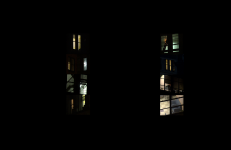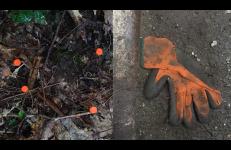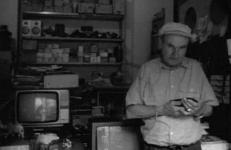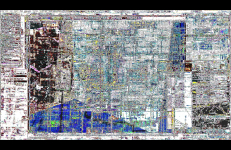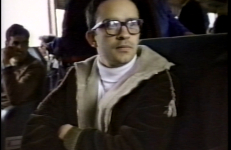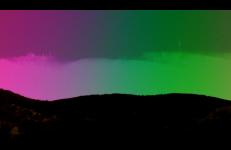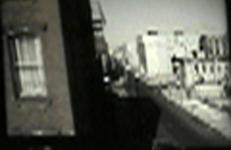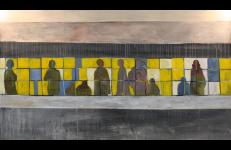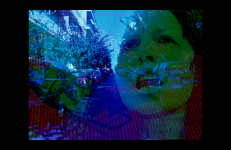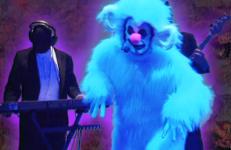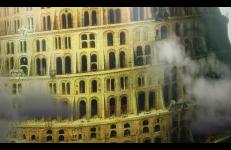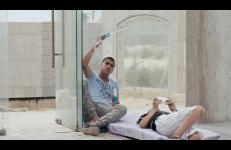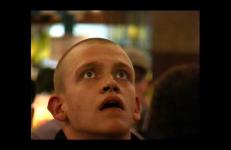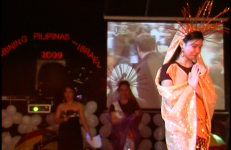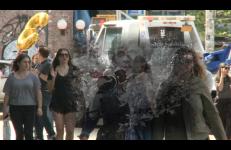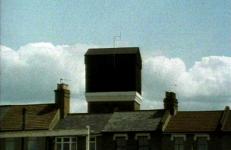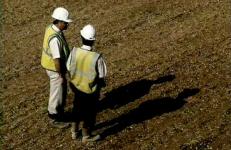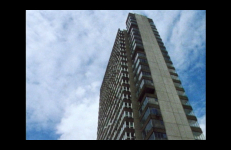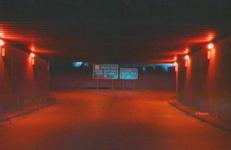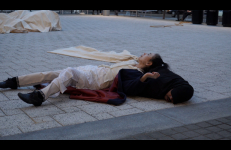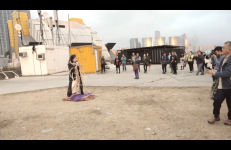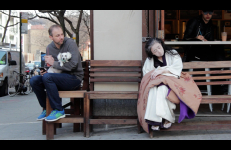The crossword puzzle addiction.
City
For over two years we made it our business to document abandoned working gloves on the streets of NYC. The feelings and thoughts that surrounded this activity connected to the ways his family relates to Gregor Samsa as a cockroach, or whatever Franz Kafka intended him to be in The Metamorphosis after his transformation from a productive citizen to a useless insect. When Gregor can't grant them a comfortable life-style any longer, his family starts to resent and hate the once loved and respected provider, finds him disgusting.
In this interview, American filmmaker, teacher, and video artist Peggy Ahwesh (b.1954) delves into the key figures and primary texts that have inspired her work in Super-8 and video since the 1970s. She discusses her early influences as a member of the underground art scenes in Pittsburgh in the late 70s and Soho’s Kitchen in the 80s. Ahwesh’s experimental hand-processing and controversial subject matter can be traced to feminist theory, and her exposure to underground experimental films, including works by Werner Herzog, George Amaro, Kenneth Anger, Jack Smith and her teacher at Antioch College, Tony Conrad.
A portrait of an unnamed city in Italy. Sidestepping the tourist attractions that make the city famous, the film/video posits an almost-imaginary place that draws closer to the reality of its inhabitants. Using a voiceover narration that collages direct observation, literary texts, historical fact, local folklore, and a bit of sheer fabrication, the film/video melds documentary and narrative, past and present.
An all-over textile constructed under the spell of Arachne, an audiovisual textile in five parts that exposes a web of raids in construction over the american houses, a landscape of protests under the webs of segmented time, the entrails of the american factory in movement through the endless american party.
Ángel Reparador (The Healing Angel) was shot in Buenos Aires, where the artist Sergio De Loof films Bobe in different places along the route that goes from the house of his parents, in the south of the suburbs, to the city center. The piece thus reflected the practice of “yire”, common among the community gay and dissident in a city that, at that time, did not offer spaces anywhere possible to freely express homosexual love.
Documentation of the installation The Future of Metropolis at Technical University in Berlin, Germany.
“The individual is not an autonomous, solitary object but a thing of uncertain extent, with ambiguous boundaries. So too is matter, which loses much of its allure the moment it is reduced to an object, shorn of its viscosity, pressure and density. Both subject and matter resist their reduction into objects. Everything is interconnected and intertwined.”
— Kengo Kuma
Film and video maker Ken Kobland returns to the urban landscapes he filmed 20 years previously, such as the New York subway and the S-Bahn in Berlin. We leave, we travel, but it’s always the same images that we are drawn to. A moving road movie about eternal departure and arrival.
Stop action animation, paint on a single canvas.
To make this animation, I painted scenes of my daily commute from memory and photographed them. Each frame was painted on top of the previous one, each scene triggering the following scene. I collected sounds from the places and environments I painted and edited them together with the captured frames to realize the piece.
— Ezra Wube
This title is also availble on Ezra Wube Videoworks: Volume 1
A color-separation portrait of the Exarchia neighborhood of Athens, Greece, made during the Anti-Austerity protests in late 2011. In a place thick with stray cats and scooters, cops and Molotovs, ancient myths and new ruins; where fists are raised like so many columns in the Parthenon, this is a film of surfaces - of grafitti'd marble streets and wheat-pasted city walls - hand-processed in red, green, and blue.
A color-separation portrait of the Exarchia neighborhood of Athens, Greece, made during the Anti-Austerity protests in late 2011. In a place thick with stray cats and scooters, cops and Molotovs, ancient myths and new ruins; where fists are raised like so many columns in the Parthenon, this is a film of surfaces - of grafitti'd marble streets and wheat-pasted city walls - hand-processed in red, green, and blue.
San Francisco is a city where the virtual and the real co-exist. It is both a center of multi-media and Internet activity, and a city with a vibrant street life and commitment to public space. Awakening From the 20th Century explores these issues by asking the questions: Is life becoming virtual? Are we witnessing the end of the city? Will the computer replace the automobile?
This title is also available on Chip Lord Videoworks: Volume 2.
Babeldom is a city so massive and growing at such a speed that soon, it is said, light itself will not escape its gravitational pull. How can two lovers communicate, one from inside the city and one outside? This is an elegy to urban life, against the backdrop of a city of the future, a portrait assembled from film shot in modern cities all around the world and collected from the most recent research in science, technology and architecture.
"It’s a complex architectural vision equal parts awesome and terrifying… This is a film – and city – to get lost in."
In a city post-apocalypse, young men communicate only through smart devices. They make home out of urban debris. They can’t speak to each other, but are still able to dream.
Berlin Zoo is a video loop set in the train station and terminal interface of the same name. Several bystanders were captured by the artist’s camera as they are gradually overcome by a general state of disbelief – of shock and awe even – while staring upwards at the arrivals and departures timetables. This gallery of grimaces is intertwined with an eerie soundtrack of wind blowing and occasional squawks of birds. Berlin Zoo could be classified as a fake documentary on the contemporary wildlife of a metropolis, an exercise in modern day ornithology.
There are approximately 30,000 Filipino guest workers living within the State of Israel. The majority are female and work as caregivers for the elderly or sick. In Tel Aviv they live in shanty town conditions around the central bus station also known as the ‘Tachana Mercazit’. On Saturdays, buses in the Tachana do not work, and this giant modernist building is occupied by guest workers, who spend their time shopping, partying and socializing in bars, clubs and shops within the compound. Beauty contests are very popular among Filipinos both at home and abroad.
In Birth of a Nation, Jem Cohen takes his camera to Donald Trump’s presidential inauguration and to the next day’s protests.
"John Smith uses humour to repeatedly subvert and frustrate potentially threatening content in an economically constructed tale of the narrator’s descent into paranoia and, ultimately, oblivion, as he is pursued, haunted, and finally destroyed by a mysterious peripatetic black tower. Throughout, both verbal and visual imagery are low key to the point of banality; shots of familiar inner city landscapes—terraces, tower-blocks and scruffy wastelands—are set against a narrative that is laconic and bathetic in the best traditions of English suburban comedy.
"Blight was made in collaboration with composer Jocelyn Pook. It revolves around the building of the M11 Link Road in East London, which provoked a long and bitter campaign by local residents to protect their homes from demolition. Until 1994, when our houses were destroyed, both the composer and I lived on the route of this road. The images in the film are a selective record of some of the changes which occurred in the area over a two-year period, from the demolition of houses through to the start of motorway building work.
Block is a round-the-clock portrait, shot over a duration of ten months, of a 1960s tower block in south east London. The film is a portrait that developed out of this long duration spent there. Patterns of activity around the block build a rhythm and viewing experience not dissimilar to the daily observations of the security guard who watches the flickering screens with their fixed viewpoints and missing pieces of action.
An experimental documentary about the street drag racing scene on Chicago’s near West Side. This is a rambling textured film about obsession. It is about the mythos of speed for its own sake, but it’s also about waiting, and it is through waiting that The BLVD exposes community, inner-city landscapes and nomadic experiences of place. The film treats storytelling as a living medium for determining history. And it commands respect, for those who transform cars, or anything else, through passion.
M+ Museum presented A Body in Hong Kong in two locations as part of Mobile M+: Live Art, 2015. The second site she chose and performed at on December 11 and 12, 2015 was the West Kowloon Cultural District, the site where the M+ Museum would be built. Eiko perhaps covered a longer distance in this performance than any other in the past. This raw landscape, rather unusual in Hong Kong, and its political tenderness play as a background of her performance. A Body in Hong Kong is part of Otake’s ongoing project, A Body in Places.
During February and March of 2016, Danspace Project presented Platform, a month long curated program for which Eiko's solo project, A Body in Places, was the focus. At the center of the Platform's dense programs were Eiko's daily solos. Eiko presented 21 performances of A Body in Places in different locations at different times of day and night. In A Body in the East Village, both the camera and the gaze of the audience members closely follow three of these intimate and spontaneous performances.




